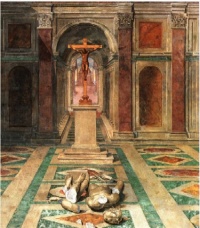Constantine the Great and Christianity
From The Art and Popular Culture Encyclopedia

|
Related e |
|
Featured: |
The Roman Emperor Constantine the Great converted to Christianity following his victory at the Battle of Milvian Bridge in 312. Under his rule, Christianity rose to become the dominant religion in the Roman Empire, and for his example of a "Christian monarch" Constantine is revered as a saint in the Eastern Orthodox Church and Oriental Orthodox Church. Not only the details of his adoption of Christianity make the religious beliefs of Constantine I interesting; theologians and historians alike have argued about the question to which form of Christianity Constantine ultimately converted, with regard to the legitimation of religious persecution.
Though Emperor Constantine I had been exposed to Christianity by his mother, Helena, there is scholarly controversy as to whether he adopted his mother's Christianity in his youth, or whether he adopted it gradually over the course of his life. Whatever the case, Constantine's endorsement of the tradition was a turning point for Early Christianity. In 313, Constantine issued the Edict of Milan, legalizing Christian worship, and the emperor would be a great patron of the Church and set a precedent for the position of the Christian Emperor within the Church and the notion of orthodoxy that would be followed for centuries. See also Christendom and the First seven Ecumenical Councils.
See also
- Constantinian shift
- Constantinianism
- Philip the Arab and Christianity
- List of rulers who converted to Christianity

